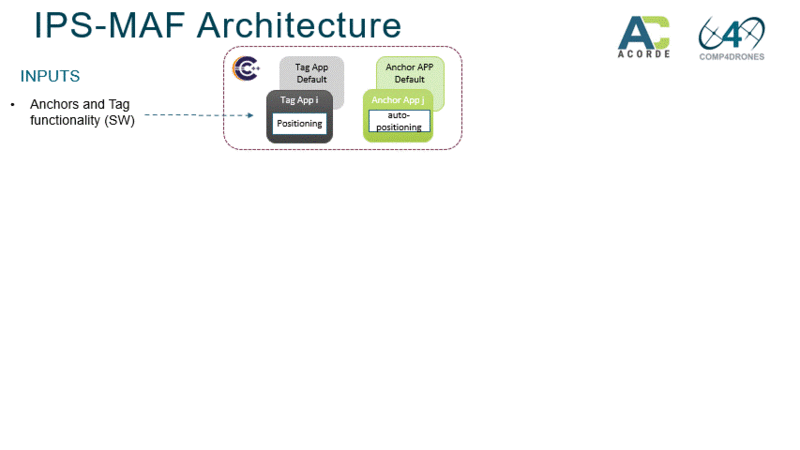WP6-21
Introduction
| ID | WP6-21 (WP6-IPS-MAF) |
| Contributor | ACORDE |
| Levels | Tool |
| Require | Linux (or Windows+WSL), Libraries: PCL, Xerces, GeographicLib, Matplotlib |
| Provide | Static and Dynamic (simulation based) of holistic model of Indoor Positioning System |
| Input | SystemC models of tag and anchor applications, XML-based description of the anchor deployment and other crucial parameters of the solution, of the configuration of the the analysis |
| Output | Static analysis outputs (Visibility, DOP, range for trcv configurations) and Dynamic analysis (accuracies, timing affected behaviour) |
| C4D tooling | System-Level modelling and analysis |
| TRL | 3 |
ACORDE IPS was motivated by the specific positioning needs and requirements for a drone flying on an large indoor scenario. The need for considering different requirements, several aspects and levels of a Cyber-physical system (tunnel geometry, deployment of anchors, algorithms for 3D positioning, platform limitations, interfaces) made early evident that a more holistic, model-based design was necessary. It motivated the development of the IPS Modelling and Analysis Framework (IPS-MAF), which, as shown in the figure below, can be used from early design stages, to build up a holistic model of the IPS system. IPS-MAF can be used to analyse and decide key aspect at different levels of the indoor positioning system (deployment of the anchors, sensitivities and transmission powers, transmission frequencies, etc) while keeping a holistic view of the system.
That is, IPS-MAF enables a holistic model of the IPS, while integrating some actual pieces of the application, so in that sense it also enables to advance some part of the application development. Therefore IPS-MAF feeds the conventional platform development and embedded application development phases, where ACORDE has already long expertise. At the same time, the measurements and characterizations that can be derived and refined from platform and application development serve to feedback and polish the holistic model. Summing up, an extended system-level design flow has been enabled, after coupling IPS-MAF to conventional ACORDE development processes for platform development (which includes PCB design, mechanical design, drivers’ development, embedded application development) and application development (where ACORDE typically develops in C or C++, relying on some cross-development environment suited to a specific microcontroller).
IPS-MAF Architecture
Following figure sketches the main architecture of IPS-MAF.
IPS-MAF is composed by two main tools:
- The IPS-MAF Analyzer
- The IPS-MAF Visualizer
A main input of IPS-MAF is the description of the anchor and tag applications. They are developed separately from the IPS-MAF tool as SystemC models. This is convenient, as this description is very close to a final C/C++ implementation, while relying on a SystemC API enables a target independent and standard description. Different application models can be separately developed and compiled and (dynamically) linked to the IPS-MAF Analysis tool. Such mapping is described in XML format.
A set of XML files serves to specify such a mapping of tag and anchor applications, and other main aspects (anchors deployment, tunnel geometry, main HW parameters like UWB transceivers configuration, tag dynamics) of the IPS with large potential impact on performance.
An additional information in XML format describes the analysis to be performed.
Status after C4D (and some demo videos)
IPS-MAF is related to the ACORDE IPS, and its development has been triggered and done in the frame of/thanks to COMP4DRONES.
After such a development, IPS-MAF provides a set of key features relevant for the design and development of IPS solutions, and specifically for large indoor infrastructures.

